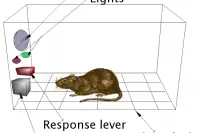Reinforcement, unlike punishment, refers to the concept of Operant Conditioning, which deals with increasing the rate of behavior. Stimulus involved in the process of reinforcement is called reinforcer.
A reinforcer can be pretty much anything ranging from biologically important things such as food, water, sex, which can also be termed as primary reinforcers, and secondary reinforcers such as praise, electric shock, and so on.
Reinforcement can be further classified into Positive Reinforcement and Negative Reinforcement, based on the kind of stimuli used to increase the rate of operant. We have made an effort to introduce the concept of Negative Reinforcement in this article.
Definition
Negative reinforcement increases the probability that an operant will occur when reinforcers (negative) are applied. Simply put, negative reinforcement is the stimuli that strengthen responses that permit an organism to avoid or escape from their presence. The stimulus or reinforcer causes the frequency of operant to increase, as it terminates or removes the undesired responses.
Skinner’s experiment on Operant conditioning can also be taken as a reference to further understand the concept of reinforcements. B.F. Skinner used Skinner box to conduct various experiments on a rat and used various reinforcers to support his theory on operant conditioning.

On one of the experiment conducted by Skinner, he placed a rat inside the box. The rat was then placed inside the chamber, similar to the experiment conducted by the professor, where he used positive reinforcement to support his theory on operant conditioning.
Here, instead of keeping the rat hungry, he
- Subjected the chamber to an unpleasant current.
- Having experienced the shock, the rat started to desperately move around the box until it finally knocked a lever by accident.
- Pressing of the lever immediately seized the flow of unpleasant current.
- After a few times, the rat had smartened enough to go directly to the lever in order to prevent itself from the discomfort.
The electric current is the negative reinforcer here, which led the rat to press the lever again and again. This shows that the negative reinforcer in the experiment succeeded in leading the rat to increase its response (of pressing the lever).
Examples
- An employee fails to meet the deadline, and he is made to come to work even on Sundays. The employee then works harder from next month in order to avoid having to go to work on Sundays.

- A student fails in class, and he is made to attend summer school. The action then motivates the student to work harder in future in order to avoid similar consequence.
Examples mentioned here can be easily understood. Here, the extra work day and the summer school are negative reinforcers, which cause both the employee and the student to work harder.
Is Negative Reinforcer Effective?
Negative reinforcer has been found to be remarkably effective in most cases. Negative reinforcements have been found to be effective learning solutions in people of all ages and gender. The reinforcement technique is applied mostly in case of difficult students and teenagers in practical life.
As effective as they are, there are certain factors that come into play when it comes to complete success of the method. It has been found that the procedure is most effective when it is applied immediately and consistently after each behavior. Additionally, the amount of enthusiasm and frequency tend to impact on the success rate of the procedure.
The connection between the reinforcement and the behavior is another major factor that influences success rate of negative reinforcement. If the connection is strong, then the chances of the individual repeating the task grows higher and vice versa.The short interval of time between a behavior and the presentation of negative information strengthens the connection. In other words, negative reinforcement need to be presented instantly.




